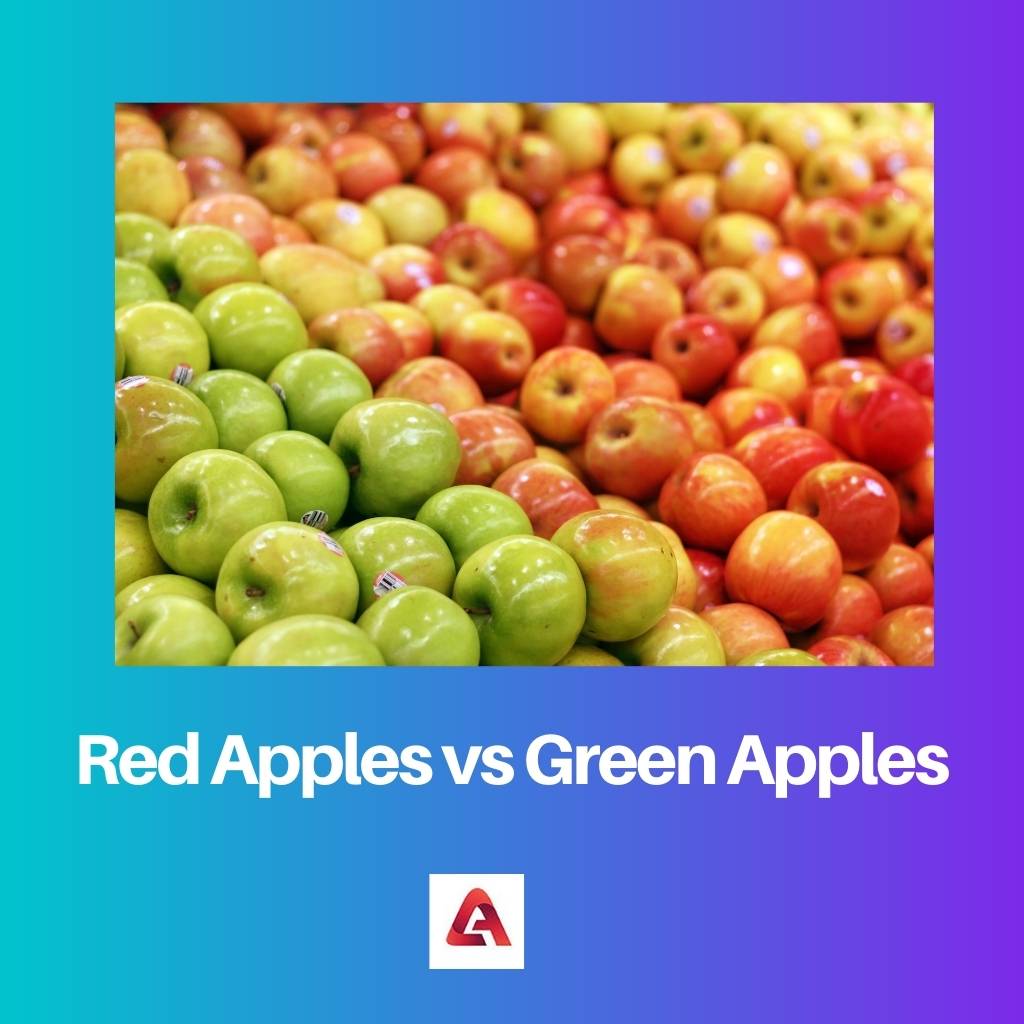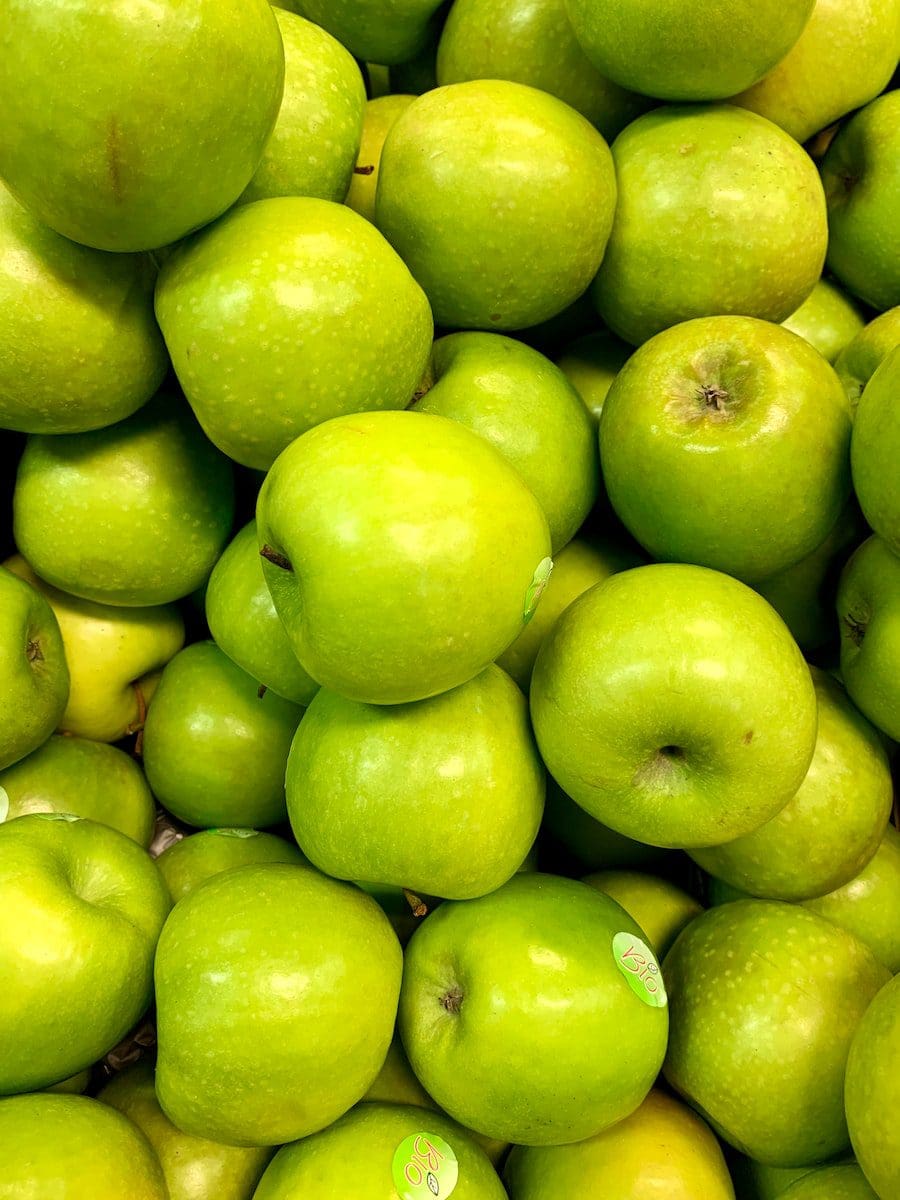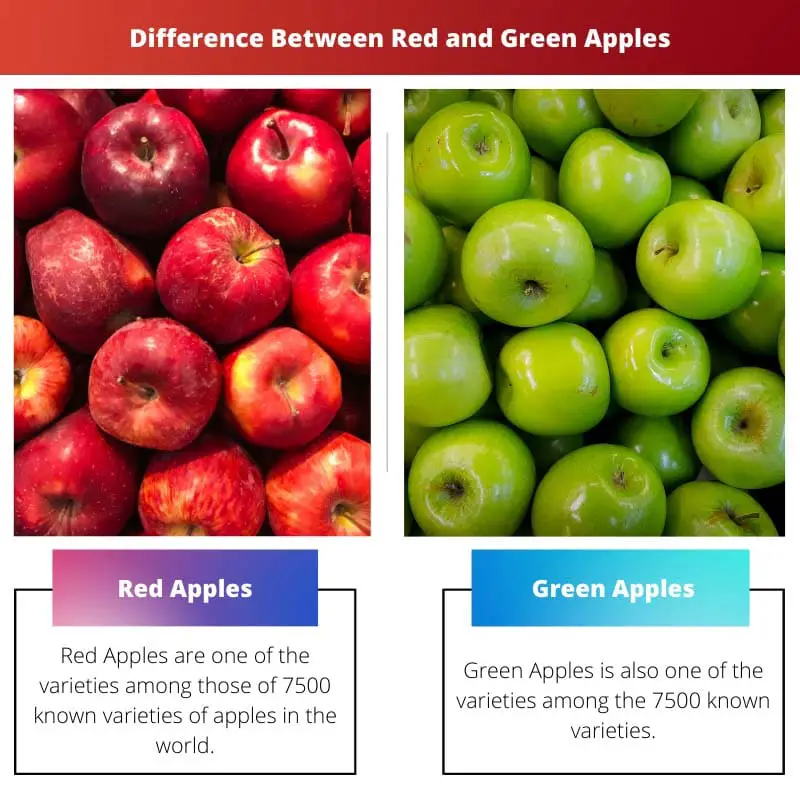There is a very famous quote or idiom in the English language that – An apple a day keeps the doctor away.
This means that a regular intake of at least one apple a day keeps an individual healthy and away from diseases. There are vivid varieties of apples found around the world.
It is a very popular fruit and high in nutritional content.
Key Takeaways
- Red apples have a higher level of anthocyanins than green apples.
- Green apples have a higher level of fiber than red apples.
- Red apples are sweeter than green apples due to their higher sugar content.
Red Apples vs Green Apples
The difference between Red Apples and Green Apples is that red color apples are that the taste of the red apples is sweet and juicy with thinness in the peel of the skin. The presence of nutrient content like – Iron, Magnesium, Protein, etc., is less in the red apples. Whereas comparatively, on the other hand, the taste of the green apples is sour along with the thickness of the peel of the skin. The nutrient content of the green apple is more.

Red Apples or Red Delicious Apples are the same variety known so far. It is the most common variety that has been eaten.
The origin of the variety took place in 1872 in Peru, Iowa, United States. It was cultivated for a competition by farmer Jesse Hiatt.
The taste of the fruit is very sweet and juicy, along with the thin peel over it.
Green Apples or Granny Smith Apples are one of the same variety. It is the third most loved and popular variety in the United States of America.
The taste of the fruit is a bit sour and feels tart. It also contains an acidic nature.
The origin of the variety is the continent of Australia.
Comparison Table
| Parameters of Comparison | Red Apples | Green Apples |
|---|---|---|
| Taste | They are sweet and juicy. | They are sour. |
| Skin | Thin | Thick |
| Origin | Peru, Iowa, United States | Australia |
| Pigment | Anthocyanin | Chlorophyll |
| Nutrition Value | They have fewer nutrients. | They have more nutrients. |
| Protein and Sugar | The protein content is less, and the sugar content is more. | The protein content is 63% more, and the sugar content is less. |
What are Red Apples?
Red Apples are one of the varieties among those of 7500 known varieties of apples in the world. These are also popular as the ‘Red Delicious Apples.’
The variety of this apple was first cultivated by a small farmer Jesse Hiatt in Peru, Iowa, United States, in the year 1872.
It was cultivated to replace Ben Davis’ apple variety in the competition organized by Stark Nurseries. And the variety ‘Hawkeye’ by Jesse Hiatt won the competition, and later the company took its rights and propagated it by itself.
The scientific name of the variety of the apple is Malus Domestica.
The taste of the red apple is sweet and juicy when eaten raw. The appearance of the fruit is hard.
The skin or the peel of the fruit is thin, juicy, and red. The color of the skin or the peel of the fruit is because of the presence of special pigments called anthocyanin.
The nutritional content or value of red apples is low. The content of fiber, protein, iron, magnesium, niacin, potassium, thiamine, vitamin A, vitamin B6, vitamin K, etc., is fewer in number.
But the presence of sugar content is higher in the red apples, including the high punch source of antioxidants.

What are Green Apples?
Green Apples are also one of the varieties among the 7500 known varieties. The green apple is also known as the ‘Granny Smith Apple.’
The significance behind the name of the variety is that it was cultivated by Maria Ann Smith from a chance seedling. The apple variety originated in Peru, Iowa, the United States, in the year 1868.
The apple bears a tip at the top and has a bit sour taste when eaten raw. The Granny Smith or Green Apple variety is a hybrid of the European wild variety of apple, Malus sylvestris, and the other domestic variety Malus Domestica.
The apple fruit is a bit hard, and the skin or the peel is thick and juicy. The fruit contains some acidic nature in it.
After baking, the green apple remains firm. That is why it is popularly used in baking pies so that it can be sweetened after it.
It is reported that after being overripened, the color of the apple changes from green to yellow. Also, in the United States of America, it is the third most popular variety of apples.
The color of the peel is green because of the presence of an excess of chlorophyll pigments. Green apples are high in nutrient values as preliminary scientific reports claimed it as the pivotal food in reducing obesity.
Less sugar, high fiber, and protein content are good for health.

Main Differences Between Red and Green Apples
- The taste of the red apples is supposed to be sweet and juicy, whereas comparatively, on the other hand, the taste of the green apples is supposed to be sour.
- The skin of the red-colored apple is thin, whereas comparatively, on the other hand, the skin of the green-colored apple is thick.
- The origin of the apples of red color is from Peru, Iowa, United States whereas comparatively, on the other hand, the origin of the apples of green color is from Australia.
- The reason behind the red color of the apples is the presence of a pigment called anthocyanin, whereas comparatively, on the other hand, the reason behind the green color of the apples is the presence of the chlorophyll pigment.
- The nutrient content or value of the red apples is less, whereas comparatively, on the other hand, the nutrient content or value of the green apples is more.
- The protein content in the red apples is less, and the sugar content of the apples is quite large, whereas comparatively, on the other hand, the protein content in the green apples is approximately 63% higher, and the presence of the sugar content is low.

- https://www.tandfonline.com/doi/abs/10.1080/07373930802686065
- https://www.sciencedirect.com/science/article/abs/pii/S0950329303000223
- https://www.sciencedirect.com/science/article/abs/pii/S1537511005000747
- https://www.sciencedirect.com/science/article/abs/pii/S0168169911002638

The historical background of how red and green apples were cultivated and their significance is fascinating. This article has provided an in-depth overview of the origin, taste, and nutritional value of these apple varieties.
I agree, Lloyd. The detailed historical information about red and green apples adds a unique perspective to understanding these fruit varieties.
This article delves into the genetic and horticultural aspects of red and green apples, shedding light on the complexities of these fruit varieties and their origins.
The detailed information about the origins, taste, and nutritional characteristics of red and green apples is enlightening and informative. The thorough analysis presented in the article adds to our understanding of these fruit varieties.
I second that, Julia. The article’s detailed coverage of red and green apples expands our understanding of these fruit varieties, underscoring their distinctive qualities and nutritional value.
I’m glad you found the article enlightening, Julia. The comprehensive exploration of red and green apples provides readers with a wealth of knowledge about these unique fruit varieties from both historical and nutritional perspectives.
The article provides valuable information about the distinct attributes of red and green apples, highlighting their unique tastes, origins, and nutritional differences. It presents a well-structured overview of these apple varieties.
I couldn’t agree more, Dmurray. The detailed description of red and green apples enhances our understanding of the diverse characteristics and qualities associated with these fruits.
The article’s thorough examination of the origins and unique attributes of red and green apples provides readers with a nuanced understanding of the complexities associated with these two fruit varieties. It’s a commendable piece of work.
Absolutely, Andrew19. The in-depth insights into red and green apples contribute to a comprehensive understanding of the distinguishing features and inherent qualities of these fruit varieties. This article is certainly enlightening.
The information presented in the article about red and green apples is both educational and comprehensive. It serves as a valuable resource for individuals interested in understanding the nuances of different apple varieties.
Learning about the specific nutritional content of red and green apples has increased my appreciation for the varied health benefits these fruits offer. I’m impressed by the detailed insights provided in this article.
Absolutely, Kimberly. Understanding the nutritional composition of fruits like red and green apples is crucial for making informed dietary choices. This article has contributed significantly to that understanding.
The comparison table is an excellent visual aid for understanding the differences between red and green apples, especially in terms of taste, skin thickness, origin, and nutritional value.
I couldn’t agree more, Tina. The side-by-side comparison presented in the table helps in grasping the unique attributes of red and green apples with clarity.
The detailed comparison of red and green apples in terms of their taste, skin thickness, origin, and nutritional value provides a well-rounded perspective on the unique attributes of these fruit varieties. This article is an excellent resource for apple enthusiasts.
I share your sentiments, Fbennett. The article’s comprehensive coverage of red and green apples gives readers an insightful look into the world of apple varieties and their distinctive characteristics.
I appreciate the detailed analysis of red and green apples, as it offers a comprehensive understanding of the unique attributes of these fruit varieties based on historical, genetic, and nutritional perspectives.
This article is a very detailed analysis of the differences between red apples and green apples, and the nutritional value of each variety. It’s essential to know the benefits of consuming fruits, and the information provided here is very insightful.
I found the explanation about red and green apples very comprehensive and informative, making it simple and easy for anyone to understand the differences between the two varieties of apples.
I appreciate the detailed description of red and green apples, as well as the comparison table, which provides a clear understanding of their characteristics and nutritional value.
The detailed information about the historical background, cultivation, and unique characteristics of red and green apples is both enlightening and informative. It offers a well-rounded perspective on these fruit varieties.
I second that, Julie. The article’s emphasis on historical context and nutritional insights enriches the understanding of red and green apples and their significance in the culinary world.
I’m glad you found the article enlightening, Julie. The in-depth analysis of red and green apples is a testament to the comprehensive research that went into creating this insightful piece.